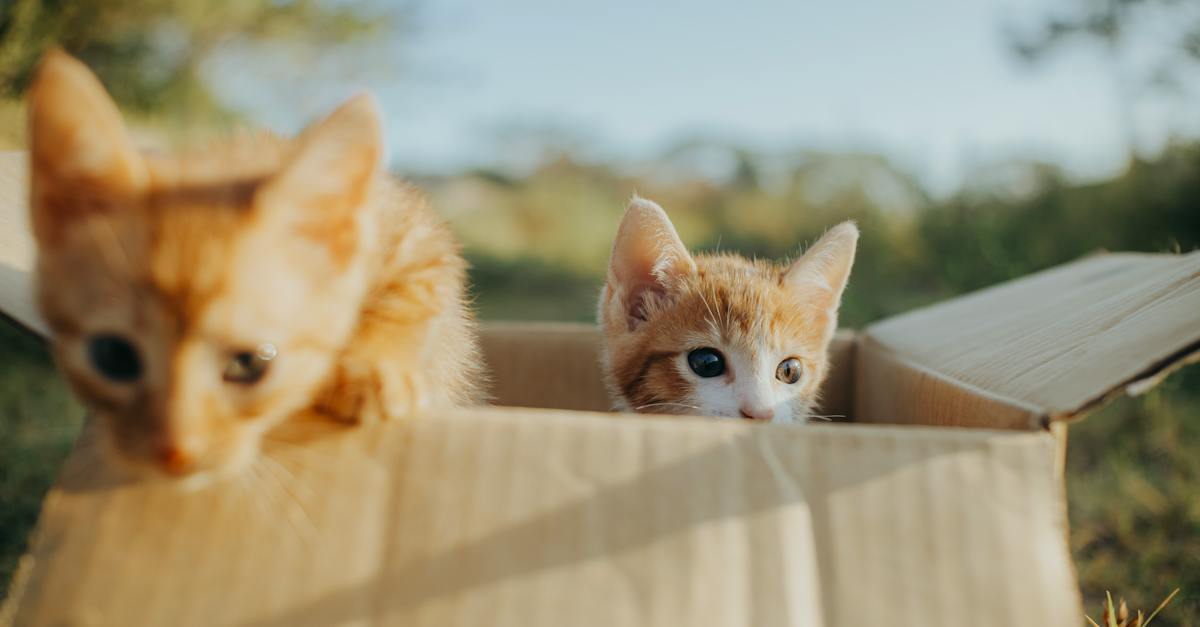Business
Expert Tips on Introducing Cats: How to Successfully Introduce Cats with Slow and Positive Methods
Learn how to introduce cats with ease! This article offers valuable tips on creating separate spaces, supervised sessions, and positive reinforcement techniques to foster a harmonious bond between your resident cat and new kitten. From preparing safe spaces to gradual introductions and scent swapping, this article covers all the necessary steps for a successful introduction. Patience is key, and don’t hesitate to consult a veterinarian or animal behaviorist for guidance along the way.
Published
1 year agoon

So, you’ve decided to bring a new furry friend into your home – a cat! Congratulations! Cats can make wonderful companions, but introducing them to each other and to their new environment can sometimes be a bit tricky. But fear not, because in this article, I’ll share with you some expert tips and tricks on how to introduce cats successfully.
In this guide, I’ll cover everything you need to know to ensure a smooth and stress-free introduction between your resident cat and the new arrival. We’ll discuss the importance of gradual introductions, creating safe spaces for each cat, and using positive reinforcement to encourage positive associations. Whether you’re introducing a new kitten to your resident cat or bringing home an adult cat, these strategies will help you establish harmony in your feline family.
The Importance of Introducing Cats Slowly
When it comes to introducing cats, one of the most important factors for a successful transition is taking things slow. Cats are territorial animals, and the introduction process needs to be gradual to ensure that both the new cat and the existing cat feel comfortable and safe in their shared environment.
Here are a few reasons why introducing cats slowly is crucial:
1. Reducing Stress:
Introducing a new cat into a home can be a stressful experience for both felines involved. By taking it slow, you can minimize stress levels and help the cats adjust more easily to their new surroundings. Rushing the process can result in anxious and aggressive behavior, making it difficult for the cats to form a positive bond.
2. Creating Positive Associations:
Slow introductions allow the cats to associate each other’s presence with positive experiences. By gradually exposing them to each other’s scent and allowing controlled visual interactions through a barrier, you give them a chance to get used to each other without feeling threatened. This builds positive associations and helps them establish a foundation for a harmonious relationship.
3. Building Trust and Confidence:
Taking the time to introduce cats slowly gives them an opportunity to build trust and confidence in each other. Through gradual interactions and positive reinforcement, they can learn to feel secure and comfortable in each other’s presence. This is particularly important for the existing cat, as they may feel territorial and threatened by the new addition. By allowing them to adjust at their own pace, you can help foster a sense of security for both cats.
4. Preventing Behavioral Issues:
Introducing cats too quickly or without proper preparation can lead to behavioral issues such as aggression, marking territory, or avoiding the litter box. By taking things slow, you can minimize the chances of these issues arising. It gives both cats time to adjust and establish a hierarchy within the household, reducing the likelihood of conflicts and stress-related behaviors.
Remember, introducing cats is a process that requires patience and careful planning. By taking the time to introduce them slowly, you increase the chances of a successful and harmonious integration.
Creating Safe Spaces for Each Cat
When introducing cats to each other, it’s important to provide them with their own safe spaces. This allows them to have a sense of security and control during the integration process. Here are some tips on how to create safe spaces for each cat:
- Designated Room: Start by designating a separate room for each cat. This will serve as their safe space where they can retreat to when they feel overwhelmed or anxious. Make sure the rooms have all the necessary essentials like food, water, litter boxes, and comfortable hiding spots.
- Scent Exchange: To help the cats become familiar with each other’s scent, swap bedding or rub towels on each cat to transfer their scent. Place these items in their respective safe spaces. This will allow them to get used to each other’s scent without direct contact.
- Gradual Introduction: Once the cats are comfortable in their safe spaces, you can start with brief supervised sessions where they can see each other from a distance. Use baby gates or cracked doors to create a barrier between them. This way, they can observe each other’s behavior without feeling threatened.
- Positive Reinforcement: During these initial interactions, offer treats and praise to both cats. This helps create positive associations with each other’s presence. It’s important to reward calm and relaxed behaviors to build trust and confidence.
- Slow Progression: As the cats become more comfortable, gradually increase the duration and decrease the distance between them. If they show signs of stress or aggression, take a step back and give them more time in their safe spaces. Never force interactions or rush the process.
Remember, the goal is to give each cat their own safe space where they can retreat and feel secure. This will help reduce stress and prevent potential conflicts. By introducing them slowly and gradually, you are giving them the best chance to build positive associations and form a harmonious relationship over time.
Stay tuned for the next section where I’ll discuss the importance of supervised interactions and positive reinforcement during the introduction process.
Using Positive Reinforcement to Encourage Positive Associations
When introducing cats to each other, it’s important to create an environment that promotes positive associations. This can be achieved through the use of positive reinforcement techniques. Positive reinforcement involves rewarding desired behaviors to encourage their repetition. By using this approach, you can help your cats associate each other’s presence with positive experiences, ultimately fostering a harmonious relationship between them.
Here are some effective ways to use positive reinforcement during the cat introduction process:
- Rewards: Offering treats or small food rewards during supervised interactions can help create positive associations. For example, if one cat approaches the other calmly, reward both cats with a treat. This will help them associate being near each other with pleasant experiences.
- Playtime: Engaging in interactive play sessions with both cats simultaneously can be a great way to promote positive interactions. Use toys that each cat enjoys and encourage them to play together. This will help them bond over a shared activity and associate each other’s presence with fun and enjoyment.
- Praise: Verbal praise can also be a powerful tool in reinforcing positive behavior. When the cats interact calmly or show signs of curiosity towards each other, praise them with a gentle and encouraging tone. This positive feedback will reinforce their good behavior and encourage them to continue engaging in positive interactions.
- Scent Exchange: Another way to create positive associations is through scent exchange. Rub a soft cloth on one cat and then place it near the other cat’s resting area, and vice versa. This will allow them to acclimate to each other’s scent and develop familiarity, which can help reduce tension and promote positive interactions.
Remember, patience is key when using positive reinforcement techniques. Allow ample time for your cats to adjust to each other and reinforce positive behaviors consistently. Gradually increase the duration and frequency of their supervised interactions to help them build trust and establish a positive relationship.
By using positive reinforcement strategies, you can help your cats feel more comfortable and confident around each other. This will set the foundation for a positive and harmonious relationship to develop over time.
Introducing a New Kitten to Your Resident Cat
When bringing a new kitten into a household that already has a resident cat, it’s important to handle the introduction process with care. Cats can be territorial creatures, and introducing a new cat to their established territory can cause stress and tension. To make the transition as smooth as possible, here are some tips for introducing a new kitten to your resident cat.
- Separate living spaces: Before bringing the new kitten home, it’s important to create separate living spaces for each cat. Designate a room for the new kitten, complete with a litter box, food, water, toys, and a cozy hiding place. This allows the resident cat to become familiar with the kitten’s scent without feeling threatened.
- Scent swapping: Cats rely heavily on their sense of smell to recognize each other. To help your resident cat become acquainted with the new kitten’s scent, you can swap bedding or place a cloth with each cat’s scent in the other cat’s designated space. This gradual exposure to each other’s scents will help them become more familiar and comfortable with one another.
- Supervised introductions: Once both cats have become accustomed to each other’s scents, it’s time to carefully introduce them to each other. Start with short, supervised sessions where they can see each other through a crack in the door or a baby gate. This visual introduction allows them to observe and gauge each other’s reactions without direct contact.
- Positive reinforcement: Rewarding your cats with treats, praise, and playtime during the introduction process helps create positive associations with each other’s presence. This encourages them to view each other as sources of enjoyment rather than a threat. Remember to be patient and consistent in your approach, as building trust and confidence takes time.
- Gradual progression: As both cats become more comfortable with each other’s presence, gradually increase the duration and proximity of their interactions. Start by allowing them to explore each other’s spaces while supervised, and eventually, let them interact face-to-face under close observation. Monitor their body language, and intervene if signs of aggression or tension arise.
Bringing Home an Adult Cat
Bringing home an adult cat can be an exciting and rewarding experience. Whether you’re adopting from a shelter or bringing home a cat from a previous owner, it’s important to create a smooth transition for your new feline friend.
Here are a few steps to help you successfully introduce an adult cat to your home:
- Prepare a Safe Space – Before bringing your new cat home, make sure to prepare a separate room where they can feel safe and secure. This room should be equipped with all the essentials, such as a litter box, food and water bowls, and a cozy bed. Providing a space that is solely for your new cat will help them feel more comfortable as they adjust to their new surroundings.
- Gradual Introduction – Once your new cat has settled into their safe space, it’s time to slowly introduce them to the rest of your home. Start by allowing them to explore one room at a time, gradually increasing their access to other areas of the house. This gradual progression will help them feel more at ease and prevent overwhelming them with too much new territory at once.
- Scent Swapping – One effective way to help cats become familiar with each other is through scent swapping. Take a soft cloth or towel and gently rub it on your resident cat, then place it in the safe space of your new cat. Similarly, do the same with your new cat’s scent and place it in areas where your resident cat spends time. This process helps both cats become accustomed to each other’s scent, making the introduction process smoother.
- Supervised Interactions – When it’s time to introduce your resident cat and the new cat, it’s essential to do so in a controlled and supervised manner. Allow them to see each other through a baby gate or a crack in the door, while also providing positive reinforcement, such as treats or a favorite toy. Gradually increase their exposure to each other under close observation, ensuring that interactions remain calm and positive.
Remember, it’s essential to be patient during the introduction process. It may take some time for your cats to adjust to each other, and there may be moments of tension or aggression. If this occurs, separate the cats and try again later. Seeking guidance from a veterinarian or animal behaviorist can also be beneficial if the introduction process becomes challenging.
Conclusion
Introducing cats to each other can be a delicate process, but with the right approach, it can be successful. By following the tips and techniques outlined in this article, you can create a harmonious environment for your feline friends.
Remember to provide separate living spaces for each cat initially, allowing them to adjust to their new surroundings. Gradually introduce them to each other through supervised sessions, using positive reinforcement techniques to create positive associations.
When introducing an adult cat to a home, take the time to prepare a safe space for them and gradually introduce them to the rest of the home. Scent swapping and supervised interactions can help them become familiar with each other’s presence.
Patience is key during the introduction process, as it may take time for the cats to adjust and form a bond. If you encounter any difficulties, don’t hesitate to seek guidance from a veterinarian or animal behaviorist.
With patience, understanding, and the right approach, you can successfully introduce cats and create a loving and harmonious multi-cat household.
How can I introduce a new kitten to my resident cat?
Introduce the new kitten to your resident cat gradually. Start by keeping them in separate living spaces with their own food, litter, and toys. Allow them to smell each other’s scents under a door or through a barrier. Gradually introduce them face-to-face under supervision, rewarding positive interactions. Be patient and provide plenty of opportunities for play and positive associations.
How long does it take for cats to get used to each other?
The time it takes for cats to get used to each other varies. It can take anywhere from a few days to several weeks or even months for cats to become comfortable with each other. Factors such as their individual personalities, previous experiences, and the proper introduction process can influence this time. Patience, consistency, and positive reinforcement techniques can help expedite the process.
Should I separate my resident cat and the new kitten when I’m not around?
It is best to separate the resident cat and the new kitten when you’re not around to supervise their interactions. This is particularly important during the initial stages of the introduction process. Provide each cat with their own separate living spaces, complete with food, water, litter, and toys. This helps prevent potential conflicts and allows each cat to feel safe and secure. Gradually increase the supervised interactions as the cats become more comfortable with each other.
What should I do if my cats are not getting along?
If your cats are not getting along, try to identify the source of the issue. Ensure that each cat has their own resources, such as food, water, litter, and hiding spots. Consider consulting a veterinarian or an animal behaviorist who can provide personalized advice and guidance for your specific situation. It may be necessary to reevaluate the introduction process, provide more positive reinforcement, or implement behavior modification techniques to help resolve any conflicts between your cats. Patience and consistency are key.
With over a decade of experience in the tech industry, Priya Sharma is a seasoned software engineer and tech blogger. She holds a Bachelor's degree in Computer Science from the Indian Institute of Technology (IIT) and has been a key contributor to cutting-edge projects in artificial intelligence and software development.

You may like
Mobility Scooter


Sideways Market: Navigating the Fluctuating Trends
Understanding Market Volatility Market volatility refers to the degree of variability in the price of a financial instrument within a...


Enhance Your iPhone with Adorable Cute Wallpapers
Looking to jazz up your iPhone screen with some cuteness? Discover the impact of adorable wallpapers on your device's look...


Glow Berry Prime: The Science Behind its Skincare Revival
Discover the transformative power of Glow Berry Prime in skincare with its potent blend of 20% Vitamin C, 2% Hyaluronic...


Glov Beauty: Eco-Friendly Products Review | Glov Beauty Reviews
Discover Glov Beauty's eco-friendly products like the Glov On-The-Go set with 500+ uses and the gentle exfoliation offered by the...


Unlocking Drake’s FPS Lyrics: How Gaming Influences His Music
Discover how Drake's lyrics in the first-person shooter-inspired track "War" reflect the influence of FPS games on his music. With...


Defeating a Fire-Breathing Dragon: Strategies for Mage Survival
Prepare yourself for an intense battle as we explore how to face a dragon capable of reaching temperatures over 2000°F....


Exploring Student Life at Glitties Eckerd College
Discover the dynamic student experience at Glitties Eckerd College with a plethora of club options, competitive sports, and community service...


Discover Success Stories with Money6x Real Estate Strategy
Discover the lucrative world of real estate investing with Money6x strategy! Uncover real-life success stories of investors achieving impressive 8-12%...


Get an Inside Look at Julion Alvarez’s 2024 USA Tour
Discover the meticulous planning behind Julion Alvarez's 2024 USA tour! Dive into the world of setlist curation, choreography design, and...


Enhancing Connections through Diversity & Active Listening
Learn how treating peers with empathy and actively listening can enhance relationships and boost innovation. The article emphasizes the significance...